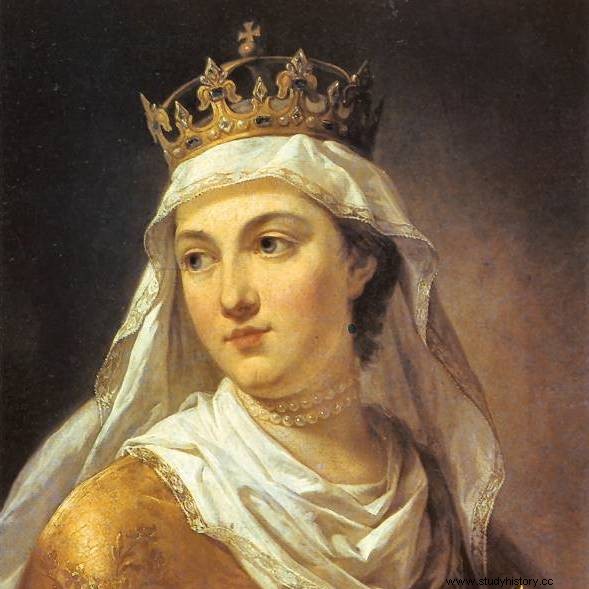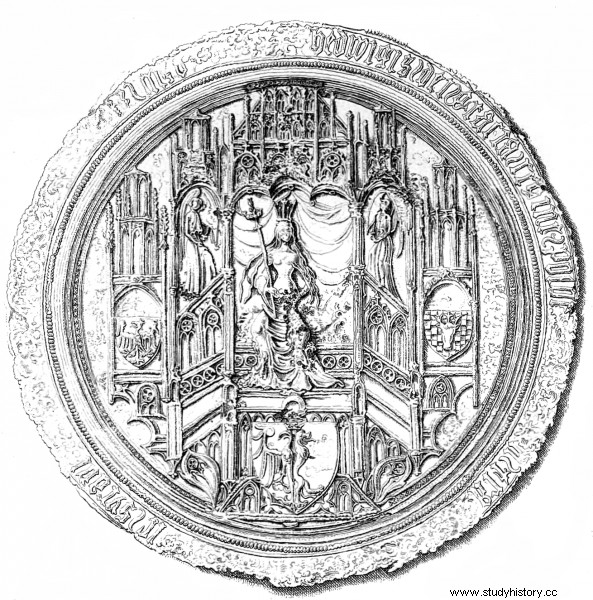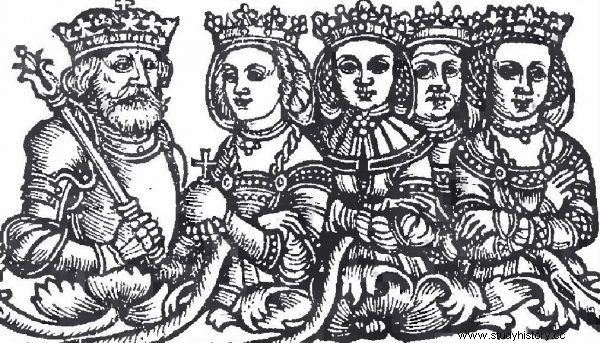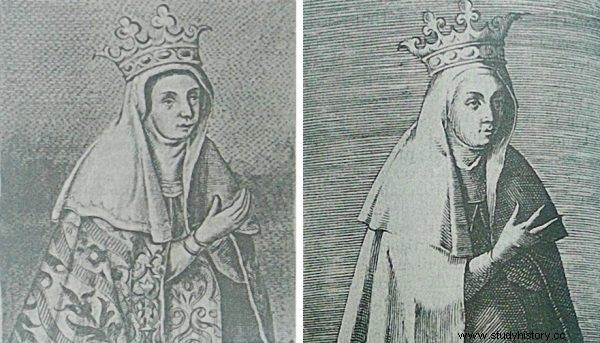Jan Długosz maintained that "there was no more beautiful woman". But the oldest portraits show a cross-eyed bogeyman with a crooked and hooked nose and unhealthy sunken eye sockets. What did Queen Jadwiga really look like?
Janko from Czarnków, known for the controversial chronicle documenting the dozen or so turbulent years that followed the death of Casimir the Great, must have known what his ruler looked like. These are political disputes leading to the imprisonment of the ten-year-old Jadwiga Andegaweńska on the Polish throne. after all, he sacrificed most of his work. Even so, he did not say a word about the appearance of the queen.
He kept his chronicle only until mid-1384, breaking the argument with a small digression about how a certain magnate from Wielkopolska invited another magnate to dinner. He ignored both the coronation case, which took place on October 16 of the same year, and all the troubles related to the ruler's marriage. He only wrote about Jadwiga that she was a "virgin". By adding neither beautiful nor prudent.
"There was no more beautiful woman." Jadwiga according to Jan Długosz
Jan Długosz had more to say. He claimed that Władysław Jagiełło "He looked at the beauty of the queen with great admiration." And that, according to the prevailing opinion, "there was no more beautiful woman in the whole world then."
He certainly exaggerated in the compliments he served, because the continent was full of ladies famous for their extraordinary beauty. Above all, however, he did not so much report facts as repeated rumors. He was born a dozen years after Jadwiga's death. And he could only use the opinions of old courtiers or preserved portraits.

Queen Jadwiga. Portrait by Marcello Bacciarelli. Did Jadwiga really have a delicate, ethereal beauty?
Seal of Queen Jadwiga
He even looked at the queen's seal. The piston was made right after the coronation, and Jadwiga presents herself proudly and majestically. Her temples are crowned with a crown, in her hands she is carrying a scepter and a royal apple. Long, loose hair flows freely down the shoulders, disappearing behind the back.
The face is small and oval, but the only imprint of the seal that has survived to the 21st century does not even allow to guess the features. On the seal, Długosz was able to see much more. Most of all, however, he probably had access to other, less schematic representations of the queen.

Queen Jadwiga's majestic seal.
Jadwiga Wilhelm's wife. The oldest extant portrait
We do not know how often Jadwiga allowed herself to be portrayed. None of the paintings depicting it have survived to our times. The oldest known image of the queen was made after her death - not in Krakow, but in Vienna. Andegawenka can be seen on the collective family tree of the Habsburg family. She is signed as ... the consort of Prince William, which only confirms that the Austrians have never come to terms with breaking off their engagement (you can read more about it in my other article).
The portrait is a historical curiosity, but it adds nothing to modern knowledge about the appearance of the queen. Jadwiga has an outfit that does not correspond to her times, she is presented schematically and does not stand out from other figures in any way. In a word:it's not really her.
Jadwiga in Queen Bona's dress? The oldest Polish image
The first Polish work in which Jadwiga was portrayed turns out to be equally useless. In 1521, the queen was placed on the board with the lineage of the Jagiellonian dynasty. You can see her there in the company of three later wives of Władysław Jagiełło.
They all look deceptively similar, and Jadwiga herself wears a dress probably modeled on… the real outfit of Queen Bona Sforza. In short, she looks more like a 16th century monarch from Italy than any lady from the 14th century.

Jadwiga as the spouse of Prince Wilhelm. An exaggerated image from the Habsburg family tree

Władysław Jagiełło and his wife. The first one from the left is Jadwiga - shown schematically, in a Renaissance dress.
Two hundred years after death. Jadwiga's first independent portraits
Portraits of Andegavenko herself do not appear until two centuries after her death. And a lot can be said about them, but certainly not that they show a particularly beautiful woman.
In the painting from 1591, Jadwiga is clearly cross-eyed, has a crooked and hooked nose, and unhealthy sunken eye sockets. In the portrait from 1594, instead of fingers, she was equipped with claws, and her round, full, wrinkled and veiled face suggests that it is not so much a young queen, but rather a nun who is advanced in years and does not control her own greed. seasoned the crown.
Finally, there is also a French portrait from the mid-17th century on which Jadwiga seems to be chewing something, and with obvious disgust. And a genealogical table from the same period with Anjou, a true Pinocchio with a heavy and swollen nose.

Not very attractive images of Jadwiga Andegaweńska from 1591 and 1594

An image of Jadwiga from 1702. In the corner you can also see an earlier, 17th-century variant of this portrait with a clearly oversized nose.
Examination of the body. What do Jadwiga's bones reveal?
The artists (or people pretending to be such) were neither able to convey the beauty of the queen, nor knew any details of her appearance. As a result, Długosz's account was not verified until the end of the 19th century. Then, during the renovation of the Wawel cathedral, a previously unknown crypt was found under the floor of the temple.
Inside was the tomb of no one else, but of Queen Jadwiga herself. It was unveiled on January 22, 1887. And immediately the best anthropologist in the city was sent:Professor Izydor Kopernicki. It was he who was tasked with faithfully recreating the appearance of the monarch. He went to work with great precision, but also with a real anointing - so as not to disturb the tomb in any way and not to damage the bones that had been there for five hundred years.
Despite the passage of time, the remains were in surprisingly good condition. As reported by the professor, even fragments of Jadwiga's skin ("scabbed and blackened" but still) have survived. Above all, the locks of her hair have survived. Contrary to the ideas established by portrait painters of that era, Jadwiga was neither a brunette nor a brunette. Kopernicki found "the remains of blonde hair with a dirty posthumous shade".
"A beautifully rounded chin." Professor Kopernicki's findings
They encircled the skull, which ... genuinely delighted the eminent bone expert. "Nowhere the slightest distortion by asymmetry, nowhere angularity," emphasized the professor. Jadwiga's face was, in his opinion, perfectly even, and the queen's chin was "beautifully rounded".

The skull of Queen Jadwiga. Photograph taken during tests carried out by Krakow specialists in the field of forensic medicine.
Angavenko's eye sockets were wide and slightly sloped, and her nose was straight, narrow and proportionate. A high forehead attracted attention. The researcher also paid a lot of attention to teeth. There was no doubt that the queen cared for and fed them well. Even half a millennium later, the teeth were "even, densely and firmly set, completely healthy and very little worn". So you can imagine that Jagiełło was captivated by the beautiful smile of his future wife from the very first moment.
He must also have noticed that for a twelve-year-old she is very tall; that it looks like it has grown beyond its age. And that he has a stature that many men would not be ashamed of.

Jadwiga according to Jan Matejko. The artist saw the queen's remains and relied on their drawing to prepare the image of Anjou.
"The appearance of the skull is masculine rather than feminine." Forensic specialists on Jadwiga's remains
All these details have already been identified by professor Kopernicki. But the full examination of not only the head, but the entire remains of the queen was not carried out until after World War II, when the underground tomb was reopened. This time, it was not anthropologists, but forensic experts:Jan Olbrycht and Marian Kusiak who were in the lead.
Thanks to them, we know that Jadwiga was an extremely tall woman, especially for the conditions of her era. She was about one hundred and seventy-two centimeters tall. Her body structure was not entirely feminine, not only because of her height, but also because of the structure of the pelvic bones. As a result, the experts found it necessary ... to conduct proof of the sex of the deceased. They are not the first, because Kopernicki already pointed out that the "general appearance of Jadwiga's skull" is "male rather than female, and this is due to the considerable size of the latter, and even more [because of] the strong, not at all delicate, though not thick bone structure" . Apparently, the queen's features were beautiful, but also sharp, and devoid of girlish delicacy.

"Queen Jadwiga before going to the wedding." Illustration from the first half of the 20th century
The researchers of Jadwiga's bones also concluded that she grew up faster than other women of similar age. At the same time, at least in her youth, she was in perfect health. "Examination of the skeleton did not reveal any pathological or traumatic changes anywhere," the researchers emphasized. There were no fractures or deep abrasions, so apparently the Queen did not ride horses very often and did not take part in hunting, as some other Polish ladies used to do.
It was also confirmed that she had teeth suitable for posters hung in dental offices. Although - contrary to Kopernicki's earlier findings - they were not completely perfect. Because one molar, evidently torn out in life, was simply missing.
***
It is impossible to present the extraordinary life and achievements of Jadwiga Andegaweńska in one short article. That is why the great queen and her no less fascinating predecessors have been devoted to the whole book: "Ladies of the Polish Empire. The Women Who Built a Power " .
Selected bibliography:
The article was based on materials collected by the author during the work on the book "Ladies of the Polish Empire. The Women Who Built a Power " . Some of these items are shown below. Full bibliography in the book.
- Bochnak A., Tombs of Queen Jadwiga and Prince Kazimierz Jagiellończyk in the Wawel Cathedral , "Studies in the history of Wawel", vol. 3 (1968).
- Graff T., Princess Jadwiga in the eyes of Janek from Czarnków [in:] In the footsteps of Saint Queen Jadwiga and her era , ed. T. Graff, Parish pw. st. Jadwigi Królowej, Krakow 2013.
- Holcer Z., Do we have a likeness of Saint Jadwiga, Queen of Poland ?, "Biblical and Liturgical Movement", No. 3 (1997).
- Nowak B., The oldest images of Jadwiga Andegaweńska as a royal daughter and monarch , "Krzysztofory. Scientific Journals of the Historical Museum of the City of Kraków, vol. 21 (2002).
- Osiński K., The marriage of Jadwiga Andegaweńska with Władysław Jagiełło in Annals of Jan Długosz , "Przegląd Prawniczy Ekonomiczny i Społeczny", vol. 2 (2014).
- Rybska K., Wives of Władysław Jagiełło in the eyes of Jan Długosz [in:] In the footsteps of Saint Queen Jadwiga and her era , ed. T. Graff, Parish pw. st. Jadwigi Królowej, Krakow 2013.
- Rydel L., Jadwiga in art [in:] The work of Jadwiga and Jagiełło , comp. W. Biliński, Publishing House of the Archdiocese of Warsaw, Warsaw 1989.
- Tobiasz M., Discovery and description of the tomb of Queen Jadwiga in 1887 , "Polonia Sacra. Theological Quarterly ”, vol. 2, issue 3 (1949).
- Tobiasz M., Opening of the tomb of Queen Jadwiga on July 12-14, 1949 , "Polonia Sacra. Theological Quarterly ”, vol. 2, issue 3 (1949).
- Wyrozumski J., Królowa Jadwiga. Between the Piast and Jagiellonian eras , Universitas, Krakow 2006.
